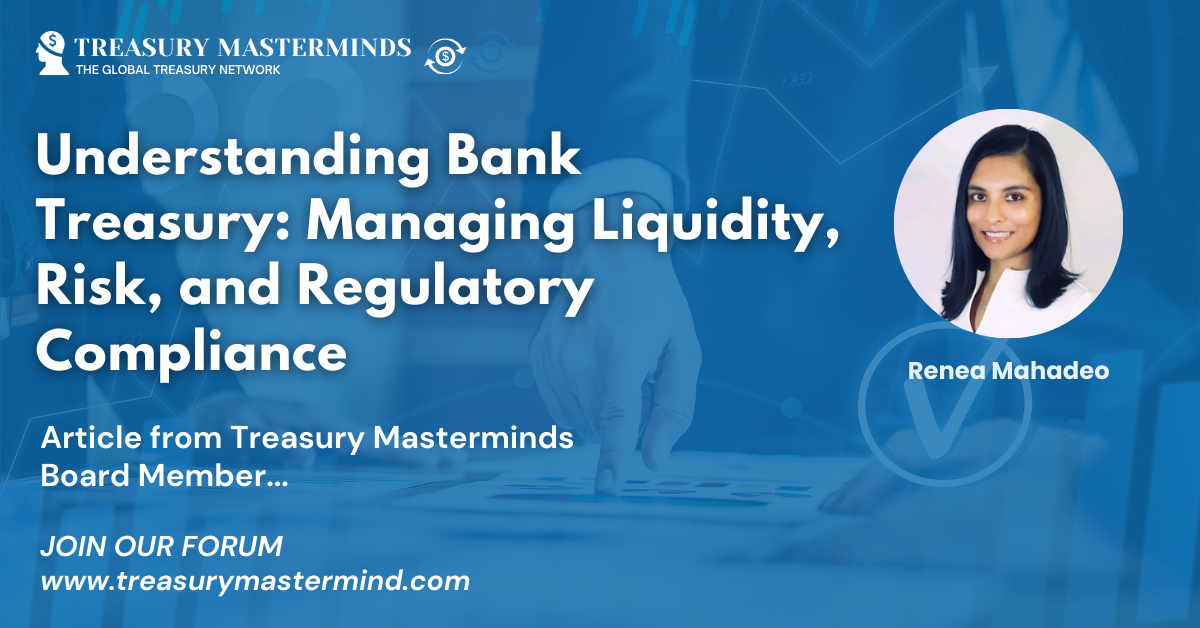

Written by Renea Mahadeo
Introduction
Bank treasury is fundamentally different from corporate treasury in its objectives and operational complexities. While corporate treasury focuses on ensuring liquidity for business operations, bank treasury is responsible for managing the financial institution’s balance sheet, optimizing liquidity, and ensuring regulatory compliance. Banks operate within a highly regulated environment where capital adequacy, liquidity risk, and interest rate exposure must be carefully managed to maintain financial stability.
The treasury function in a bank is central to its profitability and resilience, as it directly influences the institution’s ability to lend, invest, and generate returns. Bank treasurers must continuously assess market conditions, funding sources, and regulatory requirements to optimize capital allocation and maintain a robust liquidity position. The increasing integration of technology, particularly in risk analytics and automation, has transformed how bank treasury teams operate, enabling real-time decision-making and greater efficiency in regulatory reporting.

WEBINAR ALERT: Fighting Fraud in 2025: Are You Ready for the Next Generation of Threats?
Over 70% of businesses have experienced fraud attempts, and the financial impact continues to rise. As fraud tactics become more sophisticated, relying on outdated prevention strategies simply isn’t enough.
Join Tom A. (Senior Fraud Consultant UK at Trustpair) and our very own Royston Da Costa (Assistant Treasurer at Ferguson PLC) on February 20, 2025, at 11:00 AM for an essential webinar that will equip you with the latest insights and strategies to protect your organization from evolving AI-driven fraud threats. Moderated by Patrick Kunz, FRM QT
What you’ll learn:
- How cyber fraud is evolving with real-world AI-driven scams
- Why confidence gaps in fraud detection are widening and what it means for finance leaders
- How to leverage technology for real-time fraud detection
- Why breaking down organizational silos is crucial for effective fraud prevention
This session is tailored for finance professionals, treasury leaders, and risk managers who want to stay ahead of fraud risks.
Bank Treasury: Key Functions
One of the most critical functions of a bank treasury is asset-liability management (ALM), which ensures that a bank’s assets and liabilities are structured to minimize interest rate risk while maintaining profitability. Interest rate risk arises when there is a mismatch between a bank’s lending and borrowing activities, potentially affecting net interest margins. Treasury teams use financial models and scenario analysis to measure exposure and implement hedging strategies, such as interest rate swaps, to mitigate risk.
Liquidity and funding management is another essential responsibility. Banks must ensure they have adequate liquidity to meet customer withdrawals, loan disbursements, and regulatory requirements. This involves managing short-term funding sources such as interbank borrowing, repurchase agreements (repos), and wholesale funding. Compliance with Basel III liquidity regulations, including the Liquidity Coverage Ratio (LCR) and Net Stable Funding Ratio (NSFR), requires treasury teams to maintain sufficient high-quality liquid assets and ensure stable funding structures.
Funds Transfer Pricing (FTP) is a mechanism used by banks to allocate the cost of funds to different business units. Treasury determines the internal pricing of funds based on market conditions and regulatory constraints, ensuring that lending and deposit-taking activities are appropriately priced to maintain profitability. This internal pricing system is critical for optimizing a bank’s overall balance sheet performance.
Regulatory compliance is a key pillar of bank treasury operations. Compliance with Basel III, IFRS 9, and stress testing requirements ensures that banks are prepared to withstand financial shocks and maintain solvency under adverse conditions. Treasury teams work closely with risk management and regulatory reporting functions to ensure accurate reporting and adherence to capital adequacy standards.
Technology in Bank Treasury
Advanced treasury technology is essential for managing the complexity of bank balance sheets. Platforms such as Murex, QRM, and Moody’s Analytics provide sophisticated risk modeling, ALM analytics, and liquidity stress testing capabilities. These solutions enable banks to simulate economic scenarios, assess funding risks, and optimize capital allocation.
Blockchain technology is being explored by financial institutions to enhance liquidity management, reduce settlement times, and improve transparency in interbank transactions. Central banks and commercial banks are testing blockchain for real-time gross settlement (RTGS) systems, reducing counterparty risk in large-value transactions. Decentralized ledgers also provide enhanced security and auditability for treasury operations.
Artificial intelligence is being integrated into treasury operations to enhance liquidity forecasting, automate compliance reporting, and optimize hedging strategies. Real-time data analytics has become increasingly important, allowing treasury teams to respond quickly to market fluctuations and regulatory changes.
Managing Interest Rate Risk in a Regional Bank
A regional bank primarily funds its mortgage lending activities through short-term deposits. If interest rates rise, the cost of deposits increases, but mortgage rates remain fixed, reducing profitability. To manage this risk, the treasury team implements an interest rate swap strategy, converting floating-rate liabilities into fixed-rate obligations. By leveraging ALM models, they continuously assess interest rate scenarios and adjust their hedging positions, ensuring stability in net interest income.
Blockchain for Liquidity Optimization
A global bank with operations in multiple financial centers faced challenges in real-time liquidity visibility across jurisdictions. Delays in settlement and fragmented cash balances resulted in inefficient use of capital. To address this, the bank adopted a blockchain-based liquidity management solution, enabling instant cross-border settlements between its subsidiaries. Smart contracts automated intercompany transfers, reducing idle cash and ensuring compliance with Basel III liquidity requirements. The adoption of blockchain streamlined treasury operations, improving capital efficiency and regulatory compliance.
A recent example of blockchain technology being tested in Real-Time Gross Settlement (RTGS) systems is the Jasper-Ubin Project, a collaborative initiative between the Bank of Canada and the Monetary Authority of Singapore. This project explored the use of distributed ledger technology (DLT) to facilitate cross-border RTGS transactions. The pilot demonstrated that blockchain could enable real-time settlement between financial networks, reducing the expense and complexity of global payments.
Conclusion
Bank treasury is a critical function that ensures financial institutions remain liquid, profitable, and compliant with regulations. Unlike corporate treasury, which focuses on operational liquidity, bank treasury is deeply involved in balance sheet management and risk mitigation. As financial markets evolve, the integration of AI, blockchain, and advanced risk management platforms will continue to shape the future of bank treasury operations.
Also Read
- Treasury Contrarian View: AI in Treasury—Hype or Reality?
- Trends Transforming the Current Treasury Management System (TMS) Landscape
- Treasury Contrarian View: Are Treasury Certifications Still Worth It?
- Treasury Contrarian View: Treasury Without Borders—Should Treasury Teams Go 100% Remote?
- Treasury Contrarian View: Why Stop at 100% Hedging?
- Treasury Contrarian View: Banks vs. Fintechs – Should Treasurers Bet on Smaller Players?
- Lessons from 10 Years of Failing to Sell My Dad Treasury Software
- The 12 Myths of Treasury: Debunking Misconceptions and Raising Awareness
Join our Treasury Community
Treasury Mastermind is a community of professionals working in treasury management or those interested in learning more about various topics related to treasury management, including cash management, foreign exchange management, and payments. To register and connect with Treasury professionals, click [HERE] or fill out the form below to get more information.